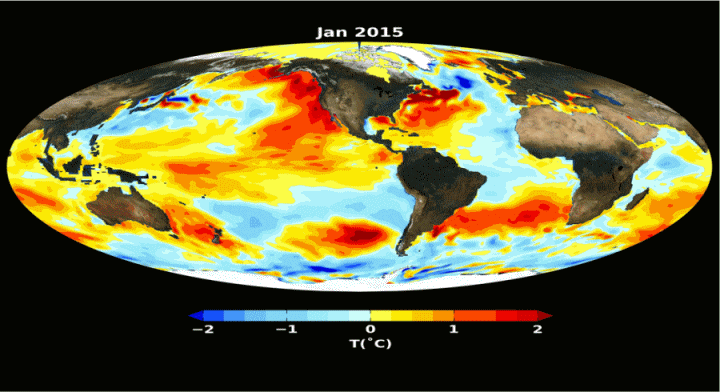THE INSTALLATION OF A NEW EL NINO REFLECTS
BY A RISE IN TEMPERATURES | |
And some parts of the globe could be particularly affected. In question, the climatic phenomenon El Niño (the little boy in French) which officially began this Thursday, according to the American agency for oceanic and atmospheric observation (NOAA). Many climatologists had indeed predicted its arrival at the end of spring 2023. It could result in a general increase in the temperature on the surface of the Earth and the appearance of several extreme meteorological episodes. Explanations. We speak of an El Niño phenomenon when the trade winds, which are regular winds blowing from east to west along the equator, weaken or change direction. This simple change has far-reaching consequences. "The ocean's response to this change in the trade winds will reinforce the initial warming", adds Jérôme Vialard, oceanographer and research director at the Research Institute for Development (IRD). In cases where the El Niño phenomenon is particularly intense, the direction of the trade winds can even reverse and accelerate the movement of warm water to the South American coasts, leading to a whole host of disastrous consequences. Masses of warm water accumulated in the western Pacific Ocean are indeed moving eastward towards the west coast of South America, changing atmospheric patterns. Areas that normally receive limited rainfall, for example, may experience heavy rainfall, while some normally humid areas may experience a period of drought. We know that temperatures can be higher than normal in some areas and lower than normal in others. Disastrous consequences Beyond the global increase in temperatures, the consequences linked to El Niño are different depending on the areas of the globe. For South America, it may be torrential rains with the risk of landslides and an ocean that no longer allows fishermen to live. On the Australian side, the phenomenon could induce an increased risk of drought, also increasing the risk of fires. The problem of drought also concerns the African continent and part of Asia with a potential drop in agricultural yields and an increase in the risk of famine. The consequences for Europe The consequences are obviously quite difficult to predict as they vary from event to event. They also depend on many factors interacting with regional climate systems. However, we do know that Europe generally experiences milder winters, cooler springs and warmer summers than normal. Among other consequences, this can have dramatic effects on agriculture, limiting crop growth in winter, while periods of drought can reduce the availability of water for irrigation. Some areas may also receive above normal rainfall, leading to increased risk of flooding, while other areas may experience periods of increased drought. El Niño events can also influence the path and intensity of storm systems in the Atlantic, which can affect coastal regions of Europe. Finally, variations in sea surface temperatures could have repercussions on marine ecosystems in the Atlantic and Mediterranean, affecting the distribution and migration of marine species. El Niño also affects marine life El Niño is also endangering marine life along the Pacific coast. Normally, a phenomenon known as "upwelling" brings cool, nutrient-rich water up from the depths of the ocean. When the El Niño phenomenon occurs, this process is suppressed or completely interrupted. There is then less phytoplankton along the coasts, which reduces the amount of food for certain fish. In March, scientists observed that sea surface temperatures reached an all-time high. El Niño is likely to worsen the situation. According to NOAA, there is a 56% chance that when the weather phenomenon reaches its peak, sea surface temperatures in the eastern Pacific will be at least 1.5 degrees Celsius above the normal. Warmer water causes coral reefs to bleach, putting them at increased risk of starvation. NOAA, which expects moderate to strong conditions, says it could last until 2024. |
|
| Boby Dean for DayNewsWorld | |
 |
|




